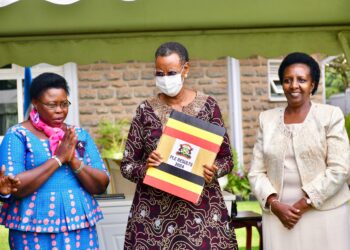The Uganda Development Bank Ltd (UDB) is proud to provide its partial Year-to-Date performance. The figures herein reflect the Bank’s full commitment to supporting the country’s economic recovery and are indeed a testament that Uganda’s economy is on track to full recovery.
The lesson that can be drawn from the impact of the COVID-19 Pandemic and the associated disruption of global supply chains is that local production in strategic commodities, as well as national self-supply to meet demand in certain commodities, can sustain economic production, job creation, utilization of domestically sourced raw materials, efficient use in technology and the deepening of market access within the East African Community and COMESA.
In the period January – May 2022, UDB has improved its capacity to deliver financing quickly and efficiently. Approval periods for loan requests continued to improve and the Bank implemented landmark services including; Special Programs, a dedicated lending service for Small, Medium Scale and growing enterprises, and Business Advisory Services, to assist applicants to be credit-ready as well as improve the sustainability of their businesses.
Together with other facilities such as the Tourism Facility being implemented in conjunction with the European Union, the Year-to-Date figures indicate growth across the Bank’s portfolio but also provide positive outlook for the government policy of import substitution, manufacturing for export, and added emphasis on agro processing.
Below is a Q&A that explains the numbers in greater detail
Question: The economy is currently undergoing a slowdown partly due to the ripple effects of Covid-19 and the on-going Ukraine-Russia war. This has hurt growth in many sectors of the economy and increased prices. What does UDB mean when it says the economy is on a path to recovery?
Answer: The evidence of recovery is in the response of strategic sectors such as primary agriculture, Agro processing and manufacturing. In the Year-to-Date figures for example we see that the greater percentage of projects funded by the Bank are in Agriculture and Industry; the largest number of approvals were in primary agriculture, followed by agro-processing and manufacturing. These often form one interlocking value chain where farm produce is increased (primary agriculture) providing raw material for processed and finished products (agro-processing and manufacturing). In terms of value, UGX176 Billion was disbursed to these three sectors (representing 69 percent of disbursements in the period). The increase in output in these areas has the most effect in job growth and support to other sectors of the economy such as trade, marketing etc. Uganda currently trades in surplus with all the East African countries in products mainly from these sectors.
QN: What is the difference between approval and disbursement?
Answer: Approvals relate to funding that has been allocated to a project. However, disbursements relate to the component of these approvals that has been made available to the borrower as per the schedule agreed with the Bank. Some projects whose implementation cycle is phased may require access/utilizing their approved funding in stages. Because of this, amounts disbursed may be less than the amounts approved. Nonetheless, the full amount approved shall however be available to the borrower in line with agreed implementation and disbursement timelines and following project supervision by the Bank.
QN: How does UDB lending directly impact on development?
Answer: UDB is a development finance institution tasked with providing financial services to generate economic activity especially in areas where other financial institutions are unable or unwilling to lend or where the private sector has a need not met by the financial industry. As such, progress is measured in what the money UDB provides does in the economy. As illustrated below the projects approved between January and May 2022 (YTD) will create significant impact on development. A total of 13,238 new direct jobs is expected to be created by these projects in their life cycle while the fi rms financed shall have a projected combined output/turnover of UGX4.0 trillion. These are further expected to generate UGX 40.59Billion in tax revenue for the government and attract foreign exchange earnings of UGX129 Billion.
| Total Loan Amount (UGX Bn) | Jobs | Output value (UGX Bn) | Tax (UGX Bn) | Forex (UGX Bn) | |
| Total | 402.70 | 13,238 | 3,963.99 | 40.59 | 128.39 |
QN: How does UDB ensure that the impact of these projects is not concentrated in a few parts of the country?
Answer: Several factors but particularly economic activity determines lending by region. However, UDB has a policy to prioritize projects by region. What this means is UDB staff work to identify, prepare and fund deserving projects from all regions of the country to spread economic development. Regions outside Kampala and sectors that are dominated by youth and women are of particular interest to the Bank. Consistent with this aspiration, the YTD approvals show a wide spread of lending per region. For example, UGX30 billion was approved for Acholi, UGX 20 billion for Ankole, UGX18 billion for Karamoja and UGX11 billion for Teso. On the other hand, in the economically active central regions, North Buganda netted UGX45 billion in approvals.
QN: UDB has in the past been accused of having very slow processes or holding back funds. Some investors have reported being frustrated by the Bank. How do you respond?
Answer: UDB strictly adheres to its terms and conditions as stipulated in the mandate and strategy to ensure that the projects will be able to repay the loans. While we are responsive to the varied needs and applications of our customers, the Bank has a duty to protect taxpayers’ money by ensuring that funds lent out are repaid. We therefore undertake a comprehensive assessment on all applications received, to ensure the Bank funds only those businesses that demonstrate not only financial viability but also the promise to create socio-economic impact in the economy. This assessment, depending on the promoters’ readiness, at times takes longer than the Bank’s desired standard. The Bank funds largely long-term projects that may be start-ups, whose assessments are different from the usual commercial bank loans whose assessments can take a shorter time. However, Bank is in final stages of developing its customer experience strategy that will help the bank provide a superior service across all fonts including turnaround time. Although the Bank is disbursing funding daily, it also collects funds daily through its banks as it is not a deposit taking institution. The cash that the Bank holds is mainly collections that will be redeployed. The cash held is also in line with the Bank’s liquidity ratios.
QN: Who is eligible for UDB funding, can anyone apply?
Answer: Every Ugandan registered business enterprise engaged in an existing or start-up business qualifies for UDB products and services if the business falls in the UDB policy, strategy and priority sectors. Applicants must be incorporated entities, Co-operatives, or registered farmer groups.
QN: Ugandans complain of having to bear the expensive cost of money. Interest rates are high. Now inflation has risen, and prices of inputs have gone up. The government says this is in part caused by the effect of the war between Ukraine and Russia. What is UDB doing to ensure access to finance at affordable rates?
Answer: UDB is a Development Finance Institution therefore a Policy Bank that is used by the government to address specific market gaps in the financial system. The current policy direction through UDB is to reduce the cost of credit to the private sector to spur private sector growth, provide long term financing, provide financing to key economic sectors that are perceived risky by other lenders and provide financing to start-ups that may not be funded by other lenders. Over time, the Bank’s lending rate has significantly reduced, from highs of 21% to the current range of 10 – 12%. Relatedly, the Bank is exploring partnerships and initiatives to de-risk lending to some of the key sectors, the benefit of which will be further reductions in cost of credit. UDB will not increase its lending rates due to the current circumstances.
QN: Any last remarks?
Answer: At UDB, we have a broad mandate, but we are resolute in accomplishing every task with utmost professionalism. To do so, we will continue to act with agility, resilience, and innovation as we create sustainable financial solutions for the everyday Ugandan. As we do so, we remain committed to our mandate to improve the quality of life of Ugandans, and at the same time to remain steadfast in defending what makes us Uganda Development Bank. Allow me to take this opportunity to thank the Government of Uganda for the support and commitment to strengthening the Bank’s capital base as it delivers its mandate to improve the quality of life of Ugandans. To date, the Government has made capital contributions amounting to UGX1.073 Trillion. It is this support that provides the fi rm foundation against which the Bank has become a model for development financing in the region and globally. UDB is recognized as the most transformed national development bank on the continent and was in December 2021 awarded “The Sustainability Leader of the Year Award” at the Karlsruhe Sustainable Awards.
I reaffirm the commitment of the Board, Management and Staff of the Bank, to continue marking a meaningful contribution towards the development of our country.
Do you have a story in your community or an opinion to share with us: Email us at editorial@watchdoguganda.com













